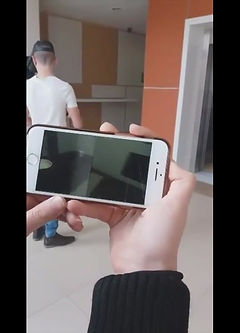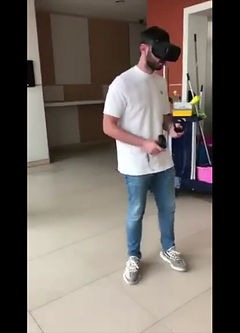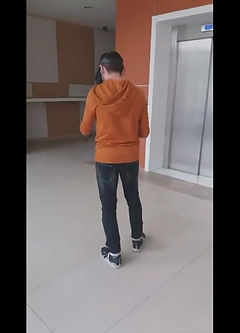Observations
The prototype was tested by eight different persons, and their behaviour towards the game and interface was noted of. We also asked for their feedback to get a clearer picture of which aspects of the game were implemented well and the ones which need further improvement. We advised the users to first start with a simple tutorial which was created with for the purpose of helping the users familiarise themselves with basic game mechanics such as option selection and grabbing objects. The following points describe our observations on the VR prototype:
Certain users skipped the option of the tutorial and had very little knowledge of what they were meant to do in the game. As a result, a forced mini-tutorial should be placed onto the players for the first minute of the game in the form of hints that disappear once a game mechanic is learned.
It was noted that some of the users experienced confusion after finishing the tutorial and starting the actual game. This is because some of the users could not figure out what objects were interactable and which weren't. They were also unaware of the main objective of the game. This problem could be addressed by providing the users with some type of narrative, or adding more to the interfaces by somehow marking the objects which could be interacted with (such as an exclamation mark hovering on the object or a glow effect).
Another observation is that most of the users tried to interact with the wardrobe inside the scene by grabbing the knob, when in reality it should be opened by pressing a button on the menu hovering next to it. This may imply that the grabbing motion is more natural for the users in some cases, instead of choosing options from a menu.
Positive feedback was given about the prototype, as many praised the the overall atmosphere of the room, particularly the small details in the furniture. The atmospheric feel was also enhanced through the background music of the game.
Furthermore, the prototype was found to be pretty engaging and realistic as most users kept wondering around the room trying to interact with more stuff even though they had already interacted with everything they could.
Users were a bit nervous when first trying the game but gained confidence quickly and managed to walk around with the VR set comfortably after a minute. It should be noted that half the users were able to grasp the 'grabbing object' mechanic faster than the other half. Perhaps the addition of a grabbing hand animation would assist users who struggle to perform it at first.

TASK 6
Observations
The prototype was tested by eight different persons, and their behaviour towards the game and interface was noted of. We also asked for their feedback to get a clearer picture of which aspects of the game were implemented well and the ones which need further improvement. We advised the users to first start with a simple tutorial which was created with for the purpose of helping the users familiarise themselves with basic game mechanics such as option selection and grabbing objects. The following points describe our observations on the VR prototype:
Certain users skipped the option of the tutorial and had very little knowledge of what they were meant to do in the game. As a result, a forced mini-tutorial should be placed onto the players for the first minute of the game in the form of hints that disappear once a game mechanic is learned.
It was noted that some of the users experienced confusion after finishing the tutorial and starting the actual game. This is because some of the users could not figure out what objects were interactable and which weren't. They were also unaware of the main objective of the game. This problem could be addressed by providing the users with some type of narrative, or adding more to the interfaces by somehow marking the objects which could be interacted with (such as an exclamation mark hovering on the object or a glow effect).
Another observation is that most of the users tried to interact with the wardrobe inside the scene by grabbing the knob, when in reality it should be opened by pressing a button on the menu hovering next to it. This may imply that the grabbing motion is more natural for the users in some cases, instead of choosing options from a menu.
Positive feedback was given about the prototype, as many praised the the overall atmosphere of the room, particularly the small details in the furniture. The atmospheric feel was also enhanced through the background music of the game.
Furthermore, the prototype was found to be pretty engaging and realistic as most users kept wondering around the room trying to interact with more stuff even though they had already interacted with everything they could.
Users were a bit nervous when first trying the game but gained confidence quickly and managed to walk around with the VR set comfortably after a minute. It should be noted that half the users were able to grasp the 'grabbing object' mechanic faster than the other half. Perhaps the addition of a grabbing hand animation would assist users who struggle to perform it at first.
Final Evaluation
The final game would have different endings which can be reached according to the sequence of actions carried out by the user. The users might get a bit lost while playing the game, hence, the interface could adapt to the user's behaviour. This could be done by highlighting the objects that can be interacted with glow effects or exclamation marks. Additionally, if the user is struggling with performing an action such as the grabbing motion, the sensitivity of the motion detection could be reduced to cater to the user's play style. This would be helpful for user's who have little game-play knowledge and technological experience such as elder users. Furthermore, in future works, the tutorial can be embedded within the game by popping up instructions in a subtle way while the user is actually playing the game. This way, the user can gain skills during the game itself without having to go through a mandatory tutorial beforehand. Due to the realism of the setting of the scene, the users automatically assume that the physics of the real world also apply to the VR game. Therefore, the interactions with objects such as doors should be done as natural and as similar to real life as possible. With such motions the user's confusion should decrease during interactions.
Escape rooms are usually solved by groups made up of two or more people, but currently our game only caters for one person at a time. Multiplayer game-play can be introduced to our game to allow multiple people solve the same escape room together. For this to be successful, the players would ideally play the game in the same room and will be able to see each other with the use of avatars.




Navigating around the Room
Prototyping Videos
The videos in this section show the players reactions when first starting the game and trying to navigate around the scene. A lot of players were not comfortable with the idea of moving around at first and preferred looking around the game environment instead. Nonetheless, all players eventually became comfortable with the game environment and mechanics and were able to move around freely. The second video to the left shows an example of what the player sees in the game by casting the occulus gameplay to a phone device.
Boundaries and Loading the Game
Interacting with UI Elements
Making Decisions in Game and Tutorial
Grabbing and Interacting with Objects




The videos in this section show the players attempting to grab objects in the game. A majority of the players had an inclination to throw objects once picking them up, hence, this could be considered in future interactions for the game (eg. throwing a ball of paper in the bin). Certain players were able to grasp the grabbing motion more naturally whilst others struggled. Players were also uncertain about which objects are grabbable, hence, these objects should be outlined through the use of prominent colours or glows.